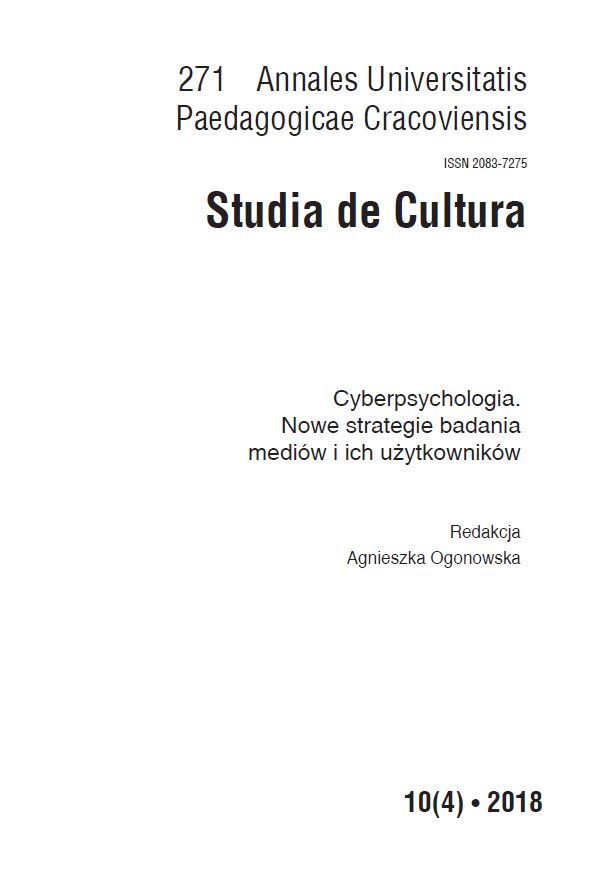Abstract
DOI 10.24917/20837275.10.4.2
Ewolucja człowieka to ewolucja jego mózgu. Wykształcenie się umysłu pozwoliło na rozwój nauki i tworzenie wynalazków, które wpłynęły na samą ewolucję. Co więcej, rozwój techniki sprawił, że zachodzi integracja człowieka z maszyną. Wymaga to już integracji wiedzy z różnych gałęzi nauki. Rozwój techniki powinien uwzględniać sytuacje, kiedy może to być wpływ dwukierunkowy o skutkach niespodziewanych. Być może to jest jedno z największych wyzwań psychologii XXI wieku.
Cyberpsychology or cybernetic psychology?
Abstract
Evolution of the human is evolution of it’s brain. This development made possible the fact that is called evolution of the machine. This evolution requires integration of knowledge from different fields. Nowadays, the technique allows the integration of man and machine. Progress gives chance of bidirectional influence between machines and humans. It must be changed in future. Engineers have to begin a multi-level discussion on technology issues that are difficult to avoid in the near future, including artificial intelligence issues. Thus, at the design stage, the engineer has to take possibility of bilateral interaction.
References
Brenton Harry, Gillies Marco, Ballin Daniel, Chatting David J. 2005. “The uncanny valley: does it exist”. http://citeseerx.ist.psu.edu/viewdoc/download;jsessionid=BB58BD-2B01C1542714E6FA1F4CC07C4D? doi=10.1.1.160.6952&rep=rep1&type=pdf (dostęp: 27.05.2018).
View in Google Scholar
Dawkins Richard. 2013. Bóg urojony. P.J. Szwajcer (przeł.). Warszawa.
View in Google Scholar
Duch Włodzisław. 1998. „Czym jest kognitywistyka?”. Kognitywistyka i Media w Edukacji nr 1. 9–50.
View in Google Scholar
Duch Włodzisław. 1997. Fascynujący świat komputerów. Poznań.
View in Google Scholar
Duffy Karen. 2000. Psychology. Columbus.
View in Google Scholar
Duiker William J., Spielvogel Jackson J. 2006. World History. Belmont.
View in Google Scholar
Feigenbaum Edward A., Feldman Julian (red.). 1972. Maszyny matematyczne i myślenie. Warszawa.
View in Google Scholar
Gibilisco Stan (ed.). 1994. Illustrated Encyclopedia of Robotics & Artificial Intelligence. New York.
View in Google Scholar
Griffin Andrew. 2015. “Stephen Hawking: Artificial intelligence could wipe out humanity when it gest too celver as humans will be like ants”. http://www.independent.co.uk/life-style/ gadgets-and-tech/news/ stephen-hawking-artificial-intelligence-could-wipe-out-humanity-when- it-gets-too-clever-as-humans-a6686496.html (dostęp: 27.05.2018).
View in Google Scholar
Grubler Gerd, Hildt Elisabeth. 2014. Brain-Computer-Interfaces in their ethical, social and cultural contexts. New York.
View in Google Scholar
Hawking Stephen, Russell Stuart, Tegmark Max, Wilczek Frank. 2014. “Stephen Hawking: «Transcendence looks at the implications of artificial intelligence – but are we taking AI seriously enough?»”. http://www.independent.co.uk/news/science/stephen- hawking- transcendence-looks-at-the-implications-of- artificial-intelligence-but-are-we-taking-9313474.html (dostęp: 27.05.2018).
View in Google Scholar
Jang Hyun J., Park Sahn W., Kwag Jeehyun. 2015. Current trends in memory implementation and rehabilitation. W Recent Progress in Brain and Cognitive Engineering. L. Seong-Whan, H.H. Bulthoff, K.-R. Muller (eds.). New York. 63–72.
View in Google Scholar
Jerz Dennis G. 2000. “Eliza – Joseph Weizenbaum”. http://jerz.setonhill.edu/if/canon/eliza.htm (dostęp: 27.05.2018).
View in Google Scholar
Kumahata Kyioshi, Kazuo Minami, Naoya Maruyama. 2016. “High-performance conjugate gradient performance improvement on the K computer”. International Journal of High Performance Computing Applications nr 30(1). 55–70.
View in Google Scholar
Kupniewski Mariusz H. 2013. Psychologia Maszyn. W Młodzi dla techniki. Wybrane problemy naukowo-badawcze mechaniki i inżynierii materiałowej. J. Wernik (red.). Sierpc.
View in Google Scholar
Kupniewski Mariusz H. 2014. W poszukiwaniu robo sapiens – modelowanie jako krok ewolucji. W Społeczny wymiar aktywności w badaniach młodych naukowców. M. Gołaszewski, A. Steliga (red.). Poznań.
View in Google Scholar
Musgrave Zach, Roberts Bryan W. 2015. “Humans, Not Robots, Are the Real Reason Artificial Intelligence Is Scary”. http://www.theatlantic.com/technology/ archive / 2015 / 08/ humans-not-robots-are-the-real-reason-artificial-intelligence- isscary / 400994/ (dostęp: 27.05.2018).
View in Google Scholar
Nazim Karol. 2006. „Inteligentny uczący się cyberspecjalista ds. ofert handlowych realizujący postulaty nowoczesnych systemów e-CRMu dla wybranej branży”. http://home.agh.edu.pl/~horzyk/pracedyplom/karolnazim-cyberspecjalista.pdf (dostęp: 27.05.2018).
View in Google Scholar
Nęcka Edward. 2003. Inteligencja. Geneza, struktura, funkcje. Gdańsk.
View in Google Scholar
Piaseczny Jan. „Czy można przeczepić duszę?”. Tygodnik Przegląd nr 17–18/2008.
View in Google Scholar
Pielesiek Krzysztof. 2011. „Powstała sztuczna ręka sterowana myślami”. http://technologie.gazeta.pl/internet/1,104530,9087190,Powstala_sztuczna_reka_sterowana_myslami. html (dostęp: 27.05.2018).
View in Google Scholar
Płociński Michał. 2012. „Dron i robot – sztuczna inteligencja w wojsku”. Rzeczpospolita 27.01.2012.
View in Google Scholar
Rohjan Susan Y. 2013. “Scientists Make Mice «Remember»” Things That Didn’t Happen”. http://www.technologyreview.com/news/517226/scientists-make-mice-remember-things- that-didnt-happen/ (dostęp: 27.05.2018).
View in Google Scholar
Sawicki Adam, Stępnik Grzegorz. 2005. „Przetwarzanie języka naturalnego”. http://regedit.i365.pl/Download/Studies/Sztuczna%20inteligencja/Przetwarzanie%20jezyka%20naturalnego.pdf (dostęp: 27.05.2018).
View in Google Scholar
Shead Sam. 2015. “Stephen Hawking warns computers will overtake humans within 100 years”. http://www.techworld.com/news/operating-systems/stephen-hawking-warns- computers-will-overtake-humans-within-100-years-3611397/ (dostęp: 27.05.2018).
View in Google Scholar
Strojnowski Michał. 2012. Wpis na forum: “If our brain were to be put beside a processor (or a couple of processors), how many GHz would it be equivalent to? And what can be the space needed to manufacture a computer similar to the human brain (in performance)?”. https://www.quora.com/If-our-brain-were- to-be-putbeside-a- processor- or-a-couple-of-processors-how-many-GHz-would-it-be-equivalent-to-And-what-can-be-the-space-needed-to-manufacture-a- computer-similar-to-the- human- brain-in-performance (dostęp: 27.05.2018).
View in Google Scholar
Szasz Thomas S. 2002. The Meaning of Mind: Language, Morality, and Neuroscience. Syracuse.
View in Google Scholar
Urbański Andrzej P. 2013. „Porównanie ludzkiego mózgu z superkomputerem”. http://www.eioba.pl/a/4cjr/porownanie-ludzkiego-mozgu-z-superkomputerem (dostęp: 27.05.2018).
View in Google Scholar
Weber Doug. 2016. “Targeted Neuroplasticity Training (TNT) (DARPA-SN-16-20)”. https://www.darpa.mil/attachments/Weber_TNT%20Overview.pdf (dostęp: 27.05. 2018).
View in Google Scholar

This work is licensed under a Creative Commons Attribution-NonCommercial 4.0 International License.
Copyright (c) 2018 Annales Universitatis Paedagogicae Cracoviensis. Studia de Cultura

